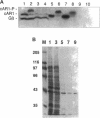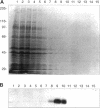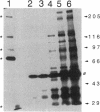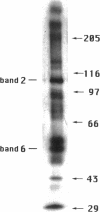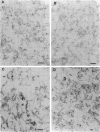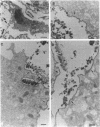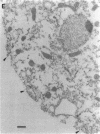Abstract
Unlike most other cellular proteins, the chemoattractant receptor, cAR1, of Dictyostelium is resistant to extraction by the zwitterionic detergent, CHAPS. We exploited this property to isolate a subcellular fraction highly enriched in cAR1 by flotation of CHAPS lysates of cells in sucrose density gradients. Immunogold electron microscopy studies revealed a homogeneous preparation of membrane bilayer sheets. This preparation, designated CHAPS-insoluble floating fraction (CHIEF), also contained a defined set of 20 other proteins and a single uncharged lipid. Cell surface biotinylation and preembedding immunoelectron microscopy both confirmed the plasma membrane origin of this preparation. The cell surface phosphodiesterase (PDE) and a downstream effector of cAR1, adenylate cyclase (ACA), were specifically localized in these structures, whereas the cell adhesion molecule gp80, most of the major cell surface membrane proteins, cytoskeletal components, the actin-binding integral membrane protein ponticulin, and G-protein alpha- and beta-subunits were absent. Overall, CHIFF represents about 3-5% of cell externally exposed membrane proteins. All of these results indicate that CHIFF is derived from specialized microdomains of the plasma membrane. The method of isolation is analogous to that of caveolae. However, we were unable to detect distinct caveolae-like structures on the cell surface associated with cAR1, which showed a diffuse staining profile. The discovery of CHIFF facilitates the purification of cAR1 and related signaling proteins and the biochemical characterization of receptor-mediated processes such as G-protein activation and desensitization. It also has important implications for the "fluid mosaic" model of the plasma membrane structures.
Full text
PDF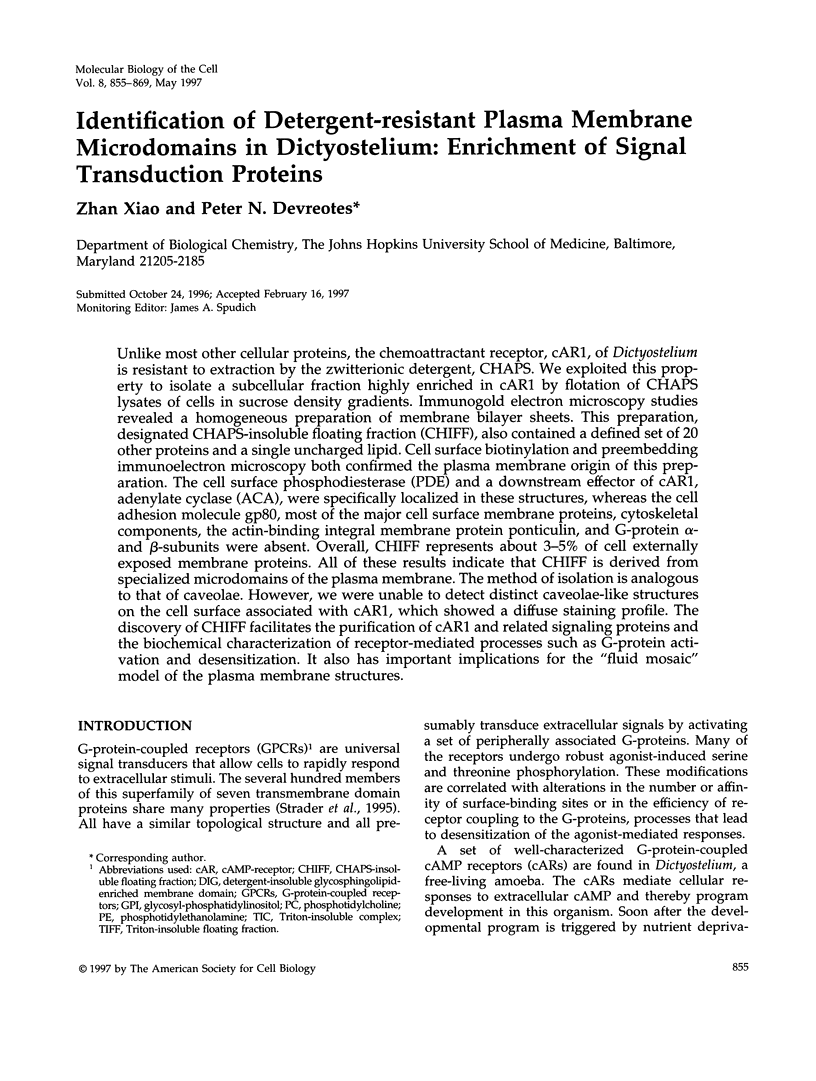
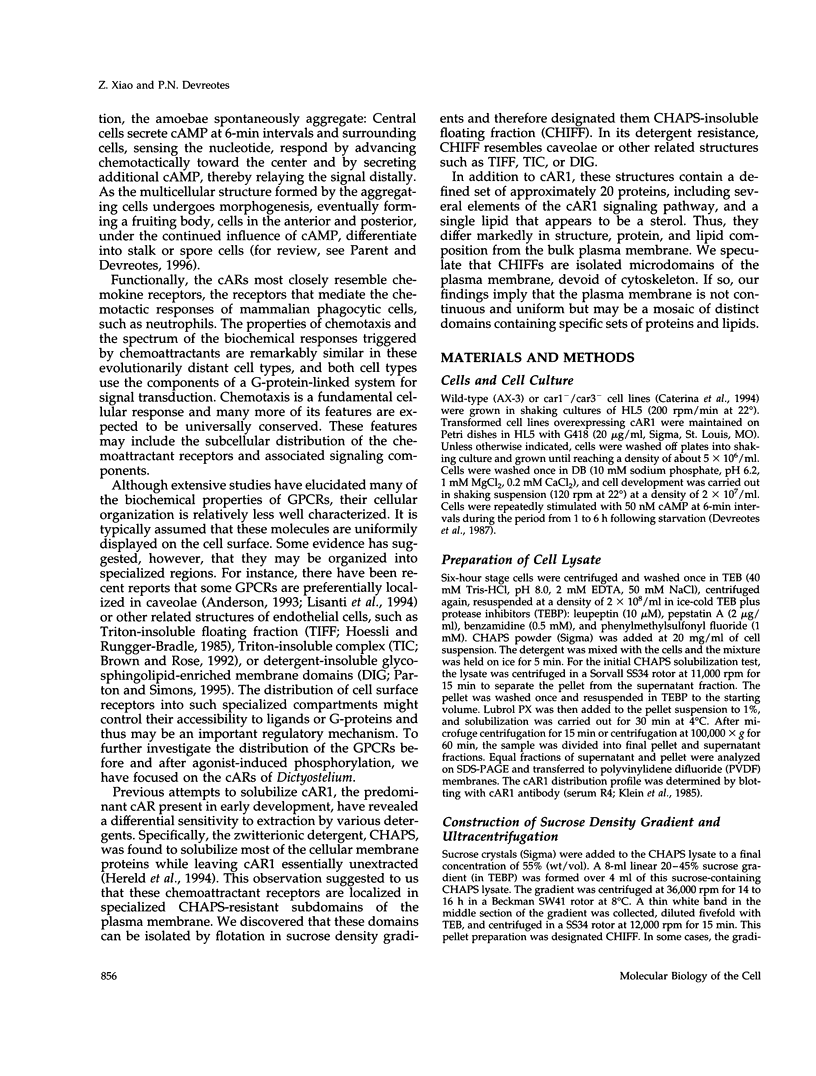
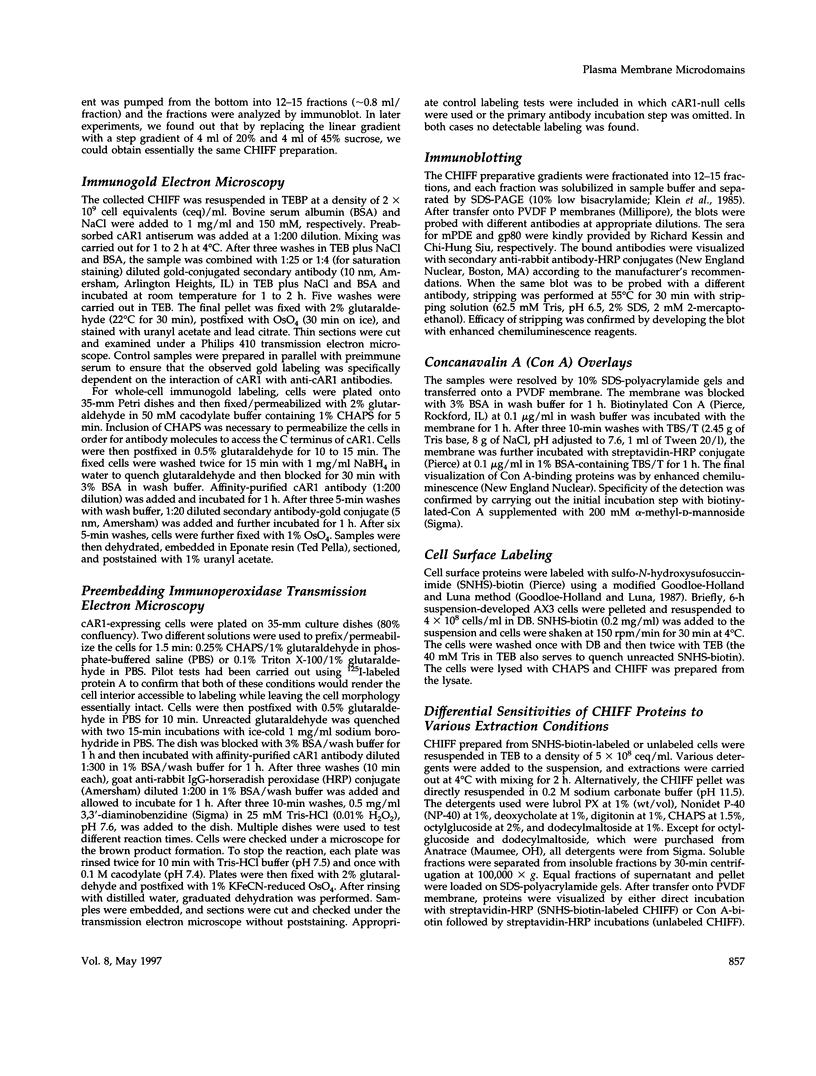
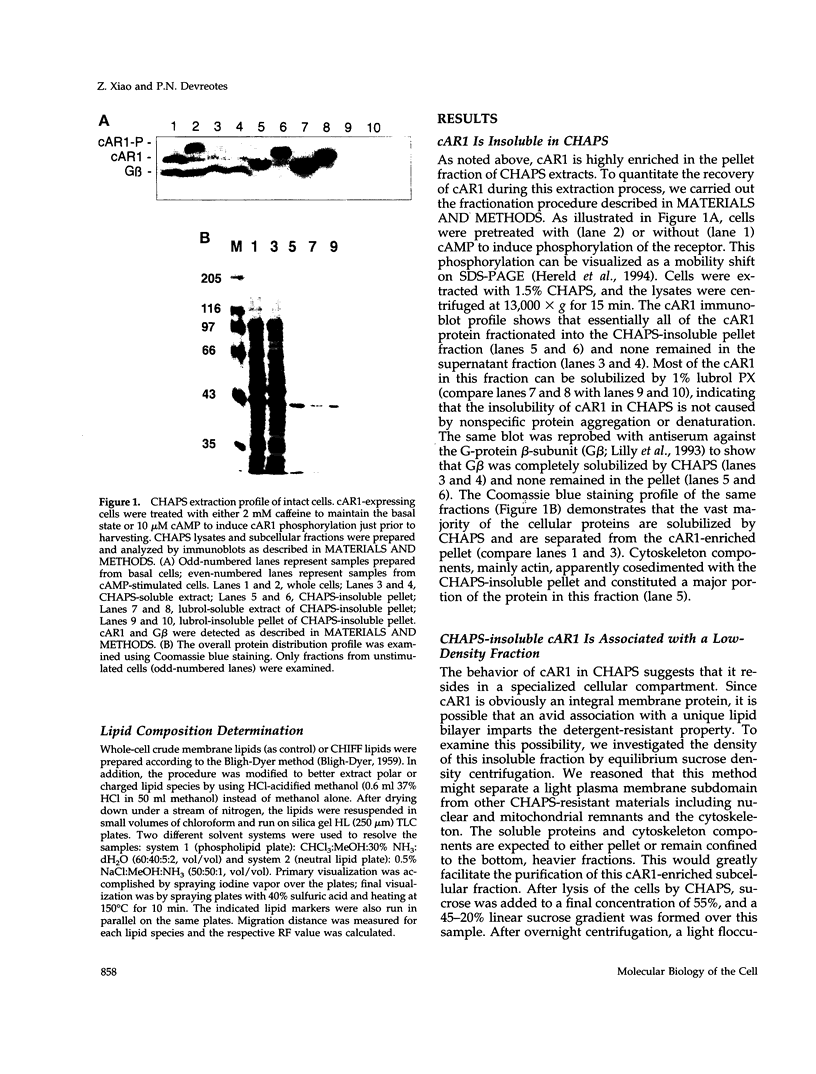
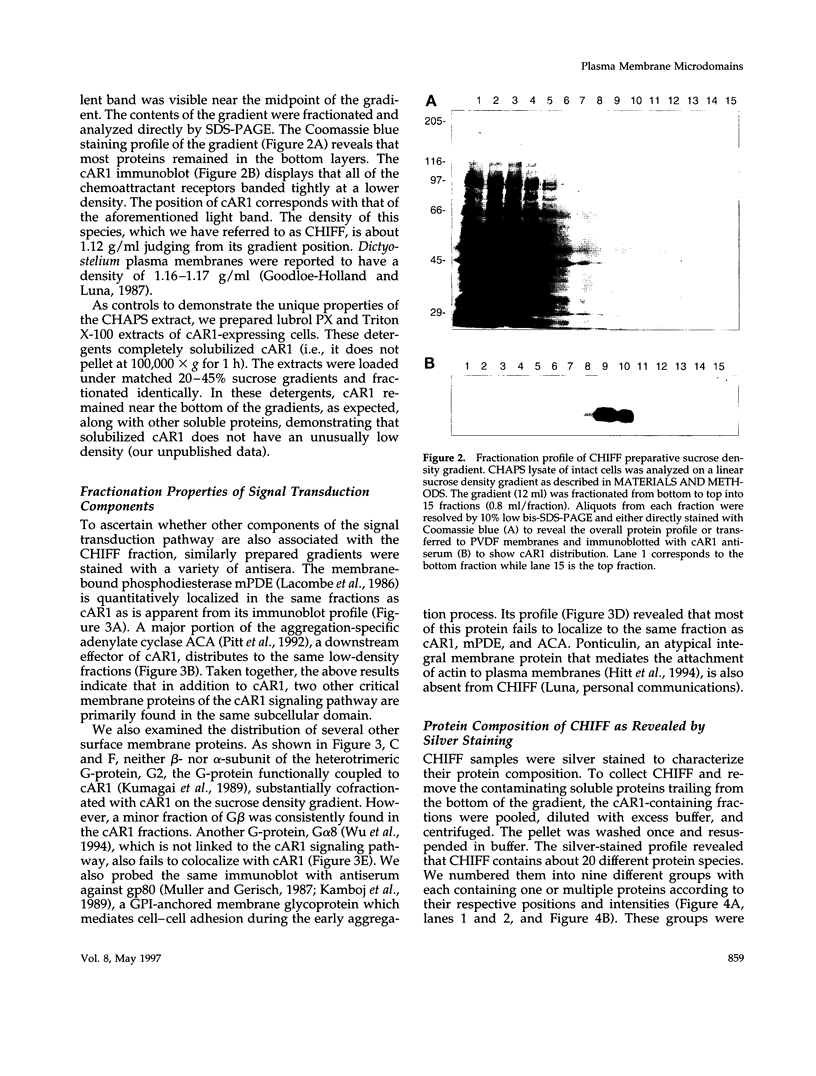
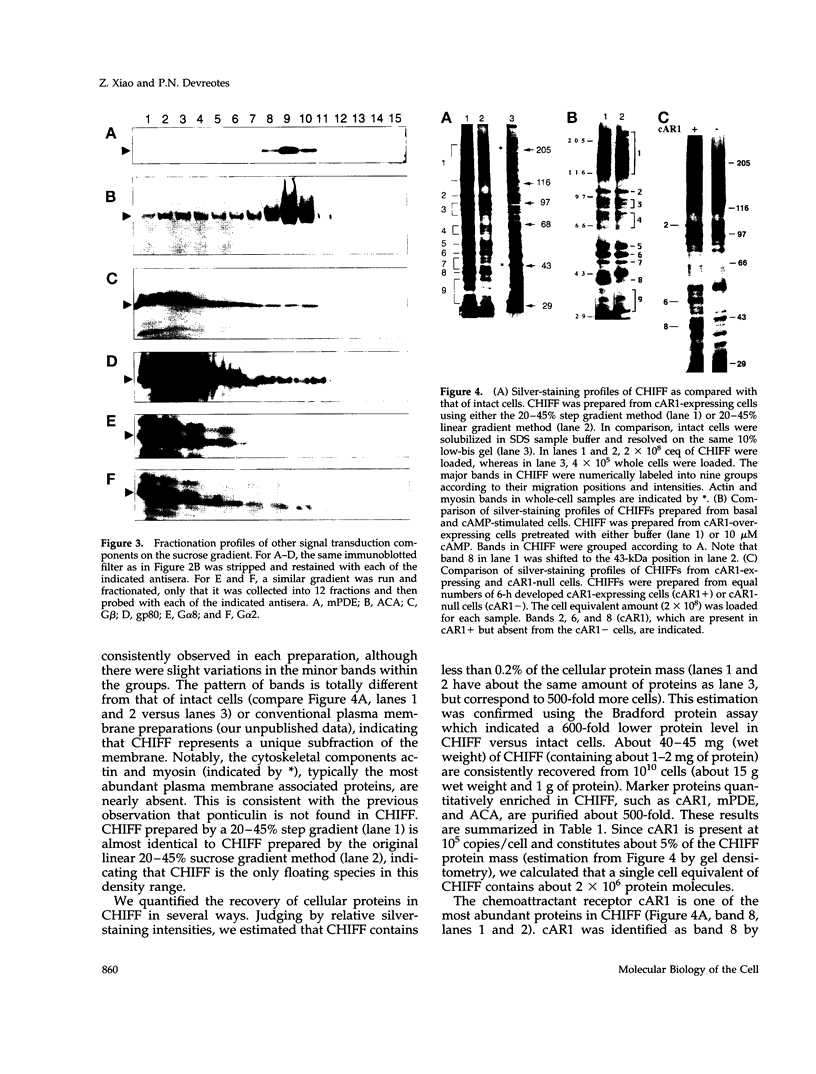
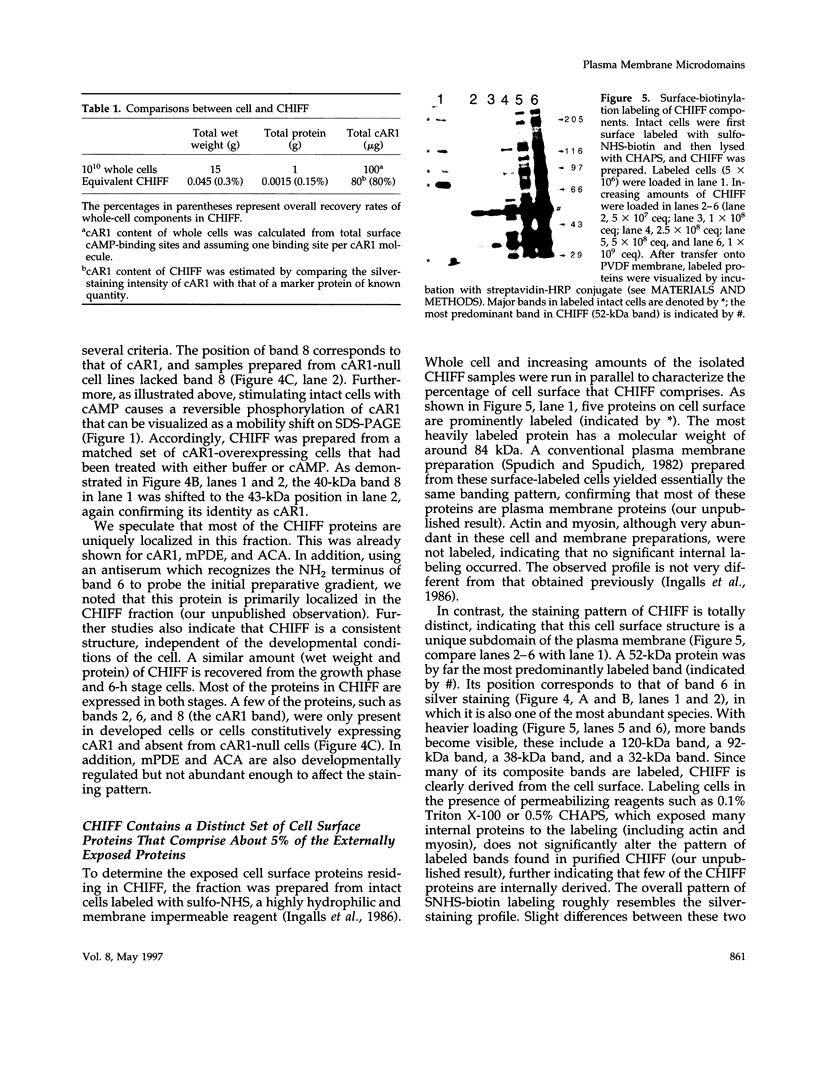
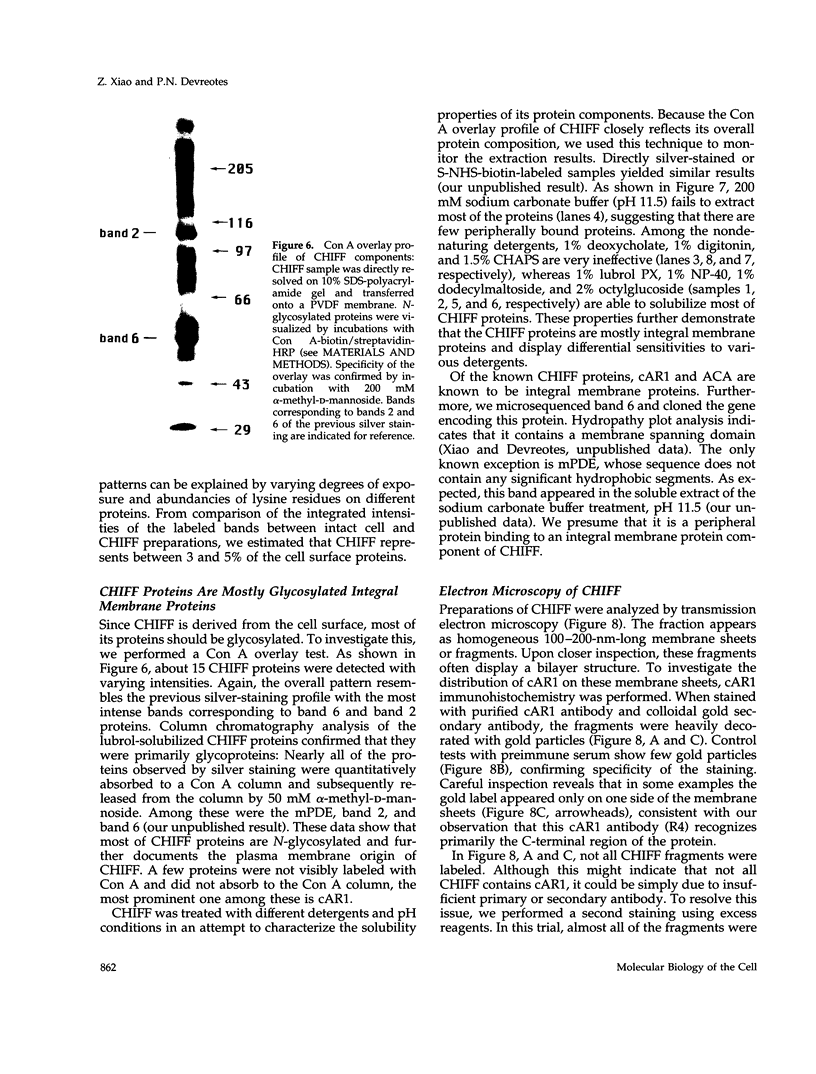
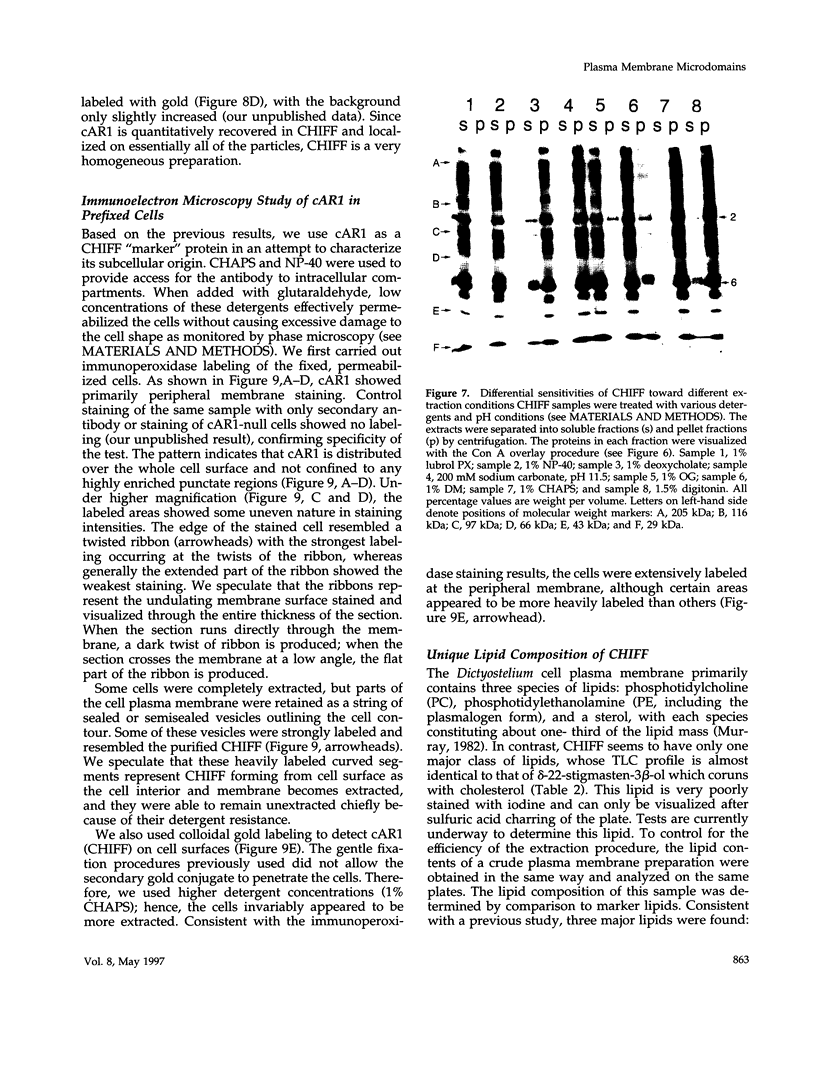
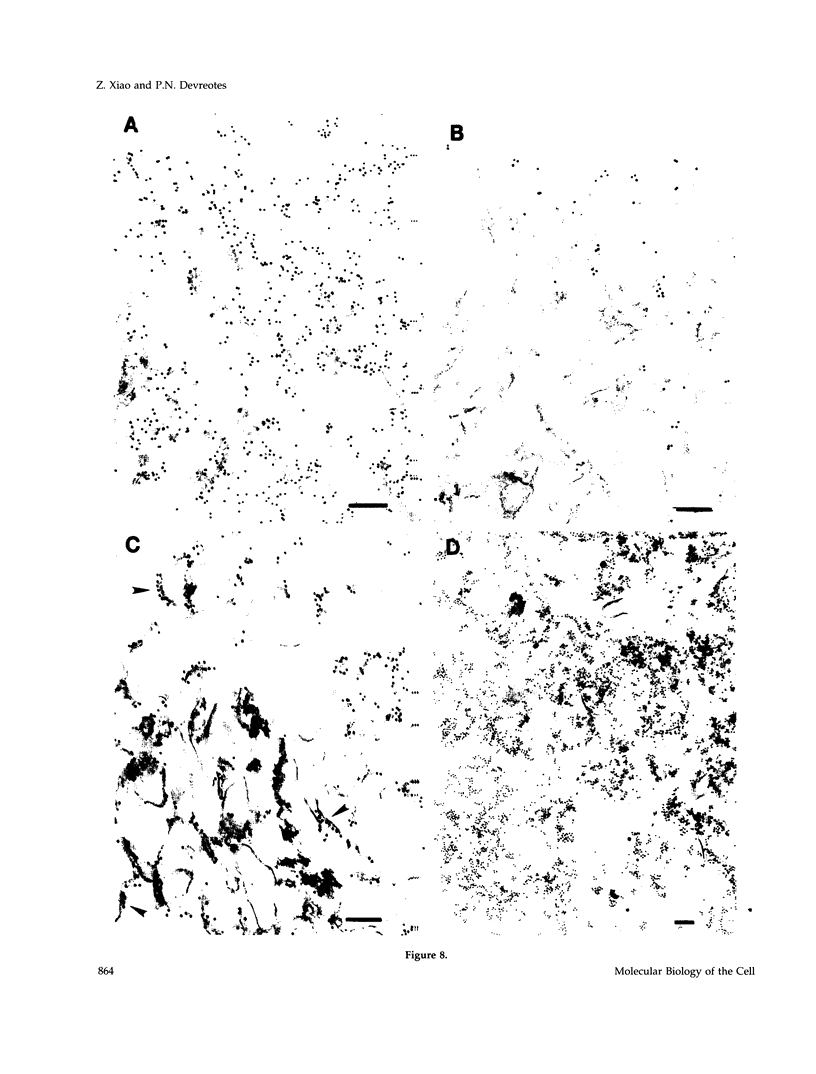
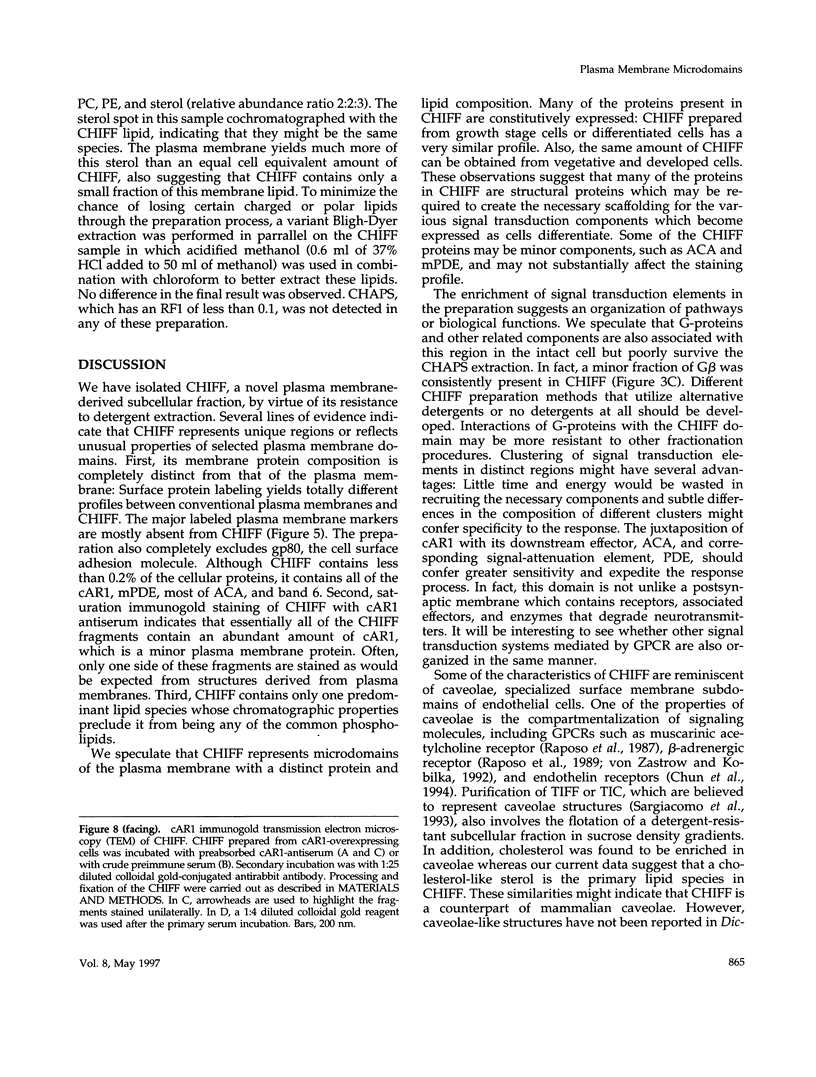
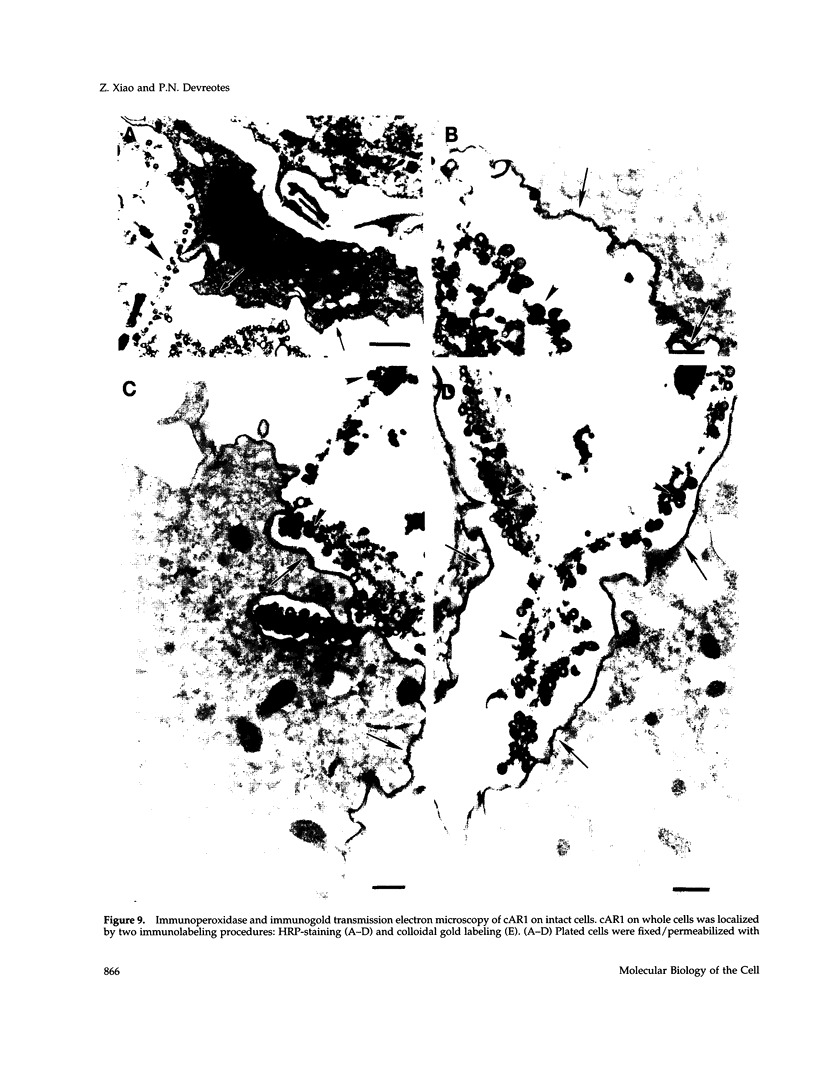
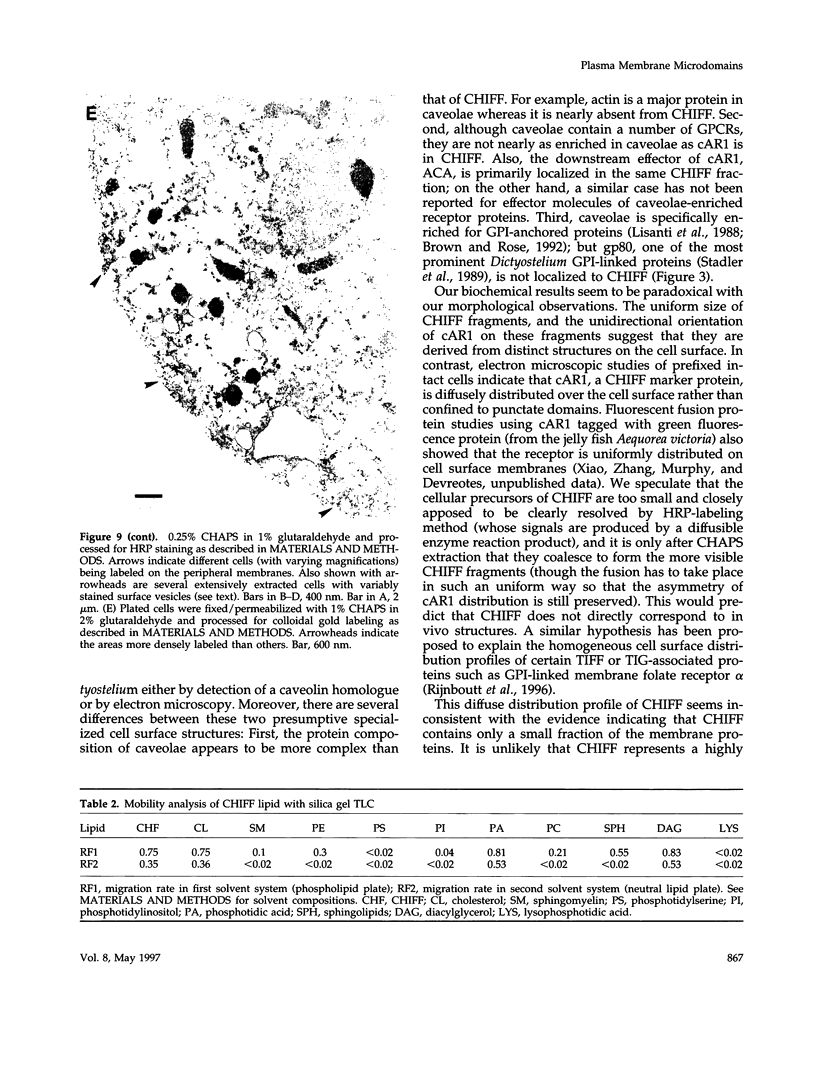

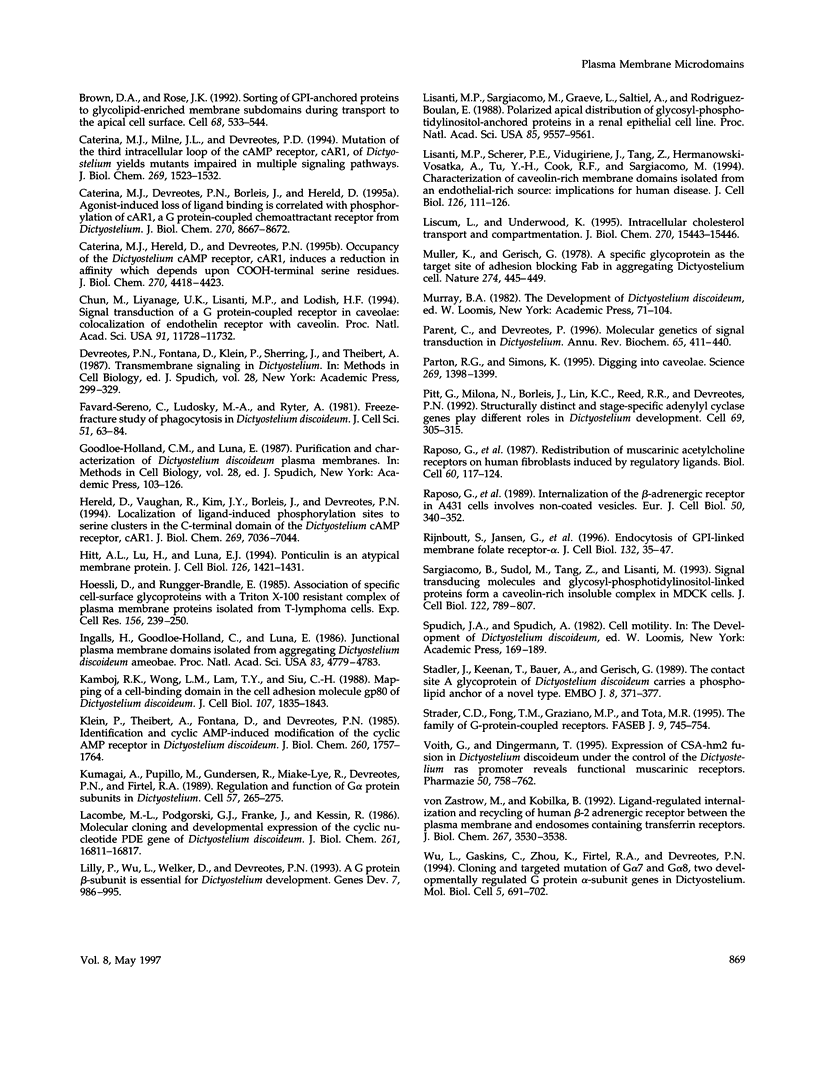
Images in this article
Selected References
These references are in PubMed. This may not be the complete list of references from this article.
- Anderson R. G. Plasmalemmal caveolae and GPI-anchored membrane proteins. Curr Opin Cell Biol. 1993 Aug;5(4):647–652. doi: 10.1016/0955-0674(93)90135-d. [DOI] [PubMed] [Google Scholar]
- BLIGH E. G., DYER W. J. A rapid method of total lipid extraction and purification. Can J Biochem Physiol. 1959 Aug;37(8):911–917. doi: 10.1139/o59-099. [DOI] [PubMed] [Google Scholar]
- Brown D. A., Rose J. K. Sorting of GPI-anchored proteins to glycolipid-enriched membrane subdomains during transport to the apical cell surface. Cell. 1992 Feb 7;68(3):533–544. doi: 10.1016/0092-8674(92)90189-j. [DOI] [PubMed] [Google Scholar]
- Caterina M. J., Devreotes P. N., Borleis J., Hereld D. Agonist-induced loss of ligand binding is correlated with phosphorylation of cAR1, a G protein-coupled chemoattractant receptor from Dictyostelium. J Biol Chem. 1995 Apr 14;270(15):8667–8672. doi: 10.1074/jbc.270.15.8667. [DOI] [PubMed] [Google Scholar]
- Caterina M. J., Hereld D., Devreotes P. N. Occupancy of the Dictyostelium cAMP receptor, cAR1, induces a reduction in affinity which depends upon COOH-terminal serine residues. J Biol Chem. 1995 Mar 3;270(9):4418–4423. doi: 10.1074/jbc.270.9.4418. [DOI] [PubMed] [Google Scholar]
- Caterina M. J., Milne J. L., Devreotes P. N. Mutation of the third intracellular loop of the cAMP receptor, cAR1, of Dictyostelium yields mutants impaired in multiple signaling pathways. J Biol Chem. 1994 Jan 14;269(2):1523–1532. [PubMed] [Google Scholar]
- Chun M., Liyanage U. K., Lisanti M. P., Lodish H. F. Signal transduction of a G protein-coupled receptor in caveolae: colocalization of endothelin and its receptor with caveolin. Proc Natl Acad Sci U S A. 1994 Nov 22;91(24):11728–11732. doi: 10.1073/pnas.91.24.11728. [DOI] [PMC free article] [PubMed] [Google Scholar]
- Devreotes P., Fontana D., Klein P., Sherring J., Theibert A. Transmembrane signaling in Dictyostelium. Methods Cell Biol. 1987;28:299–331. doi: 10.1016/s0091-679x(08)61653-2. [DOI] [PubMed] [Google Scholar]
- Favard-Séréno C., Ludosky M. A., Ryter A. Freeze-fracture study of phagocytosis in Dictyostelium discoideum. J Cell Sci. 1981 Oct;51:63–84. doi: 10.1242/jcs.51.1.63. [DOI] [PubMed] [Google Scholar]
- Goodloe-Holland C. M., Luna E. J. Purification and characterization of Dictyostelium discoideum plasma membranes. Methods Cell Biol. 1987;28:103–128. doi: 10.1016/s0091-679x(08)61639-8. [DOI] [PubMed] [Google Scholar]
- Hereld D., Vaughan R., Kim J. Y., Borleis J., Devreotes P. Localization of ligand-induced phosphorylation sites to serine clusters in the C-terminal domain of the Dictyostelium cAMP receptor, cAR1. J Biol Chem. 1994 Mar 4;269(9):7036–7044. [PubMed] [Google Scholar]
- Hitt A. L., Lu T. H., Luna E. J. Ponticulin is an atypical membrane protein. J Cell Biol. 1994 Sep;126(6):1421–1431. doi: 10.1083/jcb.126.6.1421. [DOI] [PMC free article] [PubMed] [Google Scholar]
- Hoessli D., Rungger-Brändle E. Association of specific cell-surface glycoproteins with a triton X-100-resistant complex of plasma membrane proteins isolated from T-lymphoma cells (P1798). Exp Cell Res. 1985 Jan;156(1):239–250. doi: 10.1016/0014-4827(85)90278-2. [DOI] [PubMed] [Google Scholar]
- Ingalls H. M., Goodloe-Holland C. M., Luna E. J. Junctional plasma membrane domains isolated from aggregating Dictyostelium discoideum amebae. Proc Natl Acad Sci U S A. 1986 Jul;83(13):4779–4783. doi: 10.1073/pnas.83.13.4779. [DOI] [PMC free article] [PubMed] [Google Scholar]
- Kamboj R. K., Wong L. M., Lam T. Y., Siu C. H. Mapping of a cell-binding domain in the cell adhesion molecule gp80 of Dictyostelium discoideum. J Cell Biol. 1988 Nov;107(5):1835–1843. doi: 10.1083/jcb.107.5.1835. [DOI] [PMC free article] [PubMed] [Google Scholar]
- Klein P., Theibert A., Fontana D., Devreotes P. N. Identification and cyclic AMP-induced modification of the cyclic AMP receptor in Dictyostelium discoideum. J Biol Chem. 1985 Feb 10;260(3):1757–1764. [PubMed] [Google Scholar]
- Kumagai A., Pupillo M., Gundersen R., Miake-Lye R., Devreotes P. N., Firtel R. A. Regulation and function of G alpha protein subunits in Dictyostelium. Cell. 1989 Apr 21;57(2):265–275. doi: 10.1016/0092-8674(89)90964-1. [DOI] [PubMed] [Google Scholar]
- Lacombe M. L., Podgorski G. J., Franke J., Kessin R. H. Molecular cloning and developmental expression of the cyclic nucleotide phosphodiesterase gene of Dictyostelium discoideum. J Biol Chem. 1986 Dec 25;261(36):16811–16817. [PubMed] [Google Scholar]
- Lilly P., Wu L., Welker D. L., Devreotes P. N. A G-protein beta-subunit is essential for Dictyostelium development. Genes Dev. 1993 Jun;7(6):986–995. doi: 10.1101/gad.7.6.986. [DOI] [PubMed] [Google Scholar]
- Lisanti M. P., Sargiacomo M., Graeve L., Saltiel A. R., Rodriguez-Boulan E. Polarized apical distribution of glycosyl-phosphatidylinositol-anchored proteins in a renal epithelial cell line. Proc Natl Acad Sci U S A. 1988 Dec;85(24):9557–9561. doi: 10.1073/pnas.85.24.9557. [DOI] [PMC free article] [PubMed] [Google Scholar]
- Lisanti M. P., Scherer P. E., Vidugiriene J., Tang Z., Hermanowski-Vosatka A., Tu Y. H., Cook R. F., Sargiacomo M. Characterization of caveolin-rich membrane domains isolated from an endothelial-rich source: implications for human disease. J Cell Biol. 1994 Jul;126(1):111–126. doi: 10.1083/jcb.126.1.111. [DOI] [PMC free article] [PubMed] [Google Scholar]
- Liscum L., Underwood K. W. Intracellular cholesterol transport and compartmentation. J Biol Chem. 1995 Jun 30;270(26):15443–15446. doi: 10.1074/jbc.270.26.15443. [DOI] [PubMed] [Google Scholar]
- Müller K., Gerisch G. A specific glycoprotein as the target site of adhesion blocking Fab in aggregating Dictyostelium cells. Nature. 1978 Aug 3;274(5670):445–449. doi: 10.1038/274445a0. [DOI] [PubMed] [Google Scholar]
- Parent C. A., Devreotes P. N. Molecular genetics of signal transduction in Dictyostelium. Annu Rev Biochem. 1996;65:411–440. doi: 10.1146/annurev.bi.65.070196.002211. [DOI] [PubMed] [Google Scholar]
- Parton R. G., Simons K. Digging into caveolae. Science. 1995 Sep 8;269(5229):1398–1399. doi: 10.1126/science.7660120. [DOI] [PubMed] [Google Scholar]
- Pitt G. S., Milona N., Borleis J., Lin K. C., Reed R. R., Devreotes P. N. Structurally distinct and stage-specific adenylyl cyclase genes play different roles in Dictyostelium development. Cell. 1992 Apr 17;69(2):305–315. doi: 10.1016/0092-8674(92)90411-5. [DOI] [PubMed] [Google Scholar]
- Raposo G., Dunia I., Delavier-Klutchko C., Kaveri S., Strosberg A. D., Benedetti E. L. Internalization of beta-adrenergic receptor in A431 cells involves non-coated vesicles. Eur J Cell Biol. 1989 Dec;50(2):340–352. [PubMed] [Google Scholar]
- Raposo G., Dunia I., Marullo S., André C., Guillet J. G., Strosberg A. D., Benedetti E. L., Hoebeke J. Redistribution of muscarinic acetylcholine receptors on human fibroblasts induced by regulatory ligands. Biol Cell. 1987;60(2):117–123. doi: 10.1111/j.1768-322x.1987.tb00551.x. [DOI] [PubMed] [Google Scholar]
- Rijnboutt S., Jansen G., Posthuma G., Hynes J. B., Schornagel J. H., Strous G. J. Endocytosis of GPI-linked membrane folate receptor-alpha. J Cell Biol. 1996 Jan;132(1-2):35–47. doi: 10.1083/jcb.132.1.35. [DOI] [PMC free article] [PubMed] [Google Scholar]
- Sargiacomo M., Sudol M., Tang Z., Lisanti M. P. Signal transducing molecules and glycosyl-phosphatidylinositol-linked proteins form a caveolin-rich insoluble complex in MDCK cells. J Cell Biol. 1993 Aug;122(4):789–807. doi: 10.1083/jcb.122.4.789. [DOI] [PMC free article] [PubMed] [Google Scholar]
- Stadler J., Keenan T. W., Bauer G., Gerisch G. The contact site A glycoprotein of Dictyostelium discoideum carries a phospholipid anchor of a novel type. EMBO J. 1989 Feb;8(2):371–377. doi: 10.1002/j.1460-2075.1989.tb03387.x. [DOI] [PMC free article] [PubMed] [Google Scholar]
- Strader C. D., Fong T. M., Graziano M. P., Tota M. R. The family of G-protein-coupled receptors. FASEB J. 1995 Jun;9(9):745–754. [PubMed] [Google Scholar]
- Voith G., Dingermann T. Expression of CSA-hm2 fusion in Dictyostelium discoideum under the control of the Dictyostelium ras promoter reveals functional muscarinic receptors. Pharmazie. 1995 Nov;50(11):758–762. [PubMed] [Google Scholar]
- Wu L., Gaskins C., Zhou K., Firtel R. A., Devreotes P. N. Cloning and targeted mutations of G alpha 7 and G alpha 8, two developmentally regulated G protein alpha-subunit genes in Dictyostelium. Mol Biol Cell. 1994 Jun;5(6):691–702. doi: 10.1091/mbc.5.6.691. [DOI] [PMC free article] [PubMed] [Google Scholar]
- von Zastrow M., Kobilka B. K. Ligand-regulated internalization and recycling of human beta 2-adrenergic receptors between the plasma membrane and endosomes containing transferrin receptors. J Biol Chem. 1992 Feb 15;267(5):3530–3538. [PubMed] [Google Scholar]



